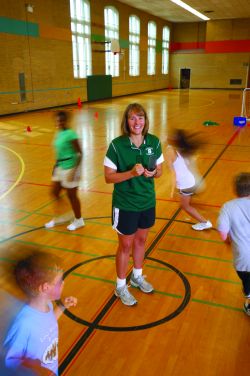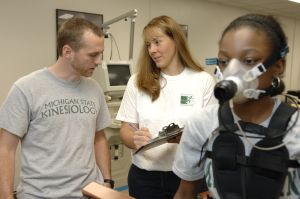 By Nicole Geary
By Nicole Geary
Karin Pfeiffer felt compelled to promote fitness long before public concerns about child obesity reached critical mass.
She was the kid in the backyard organizing all kinds of games, the high school basketball captain and the undergrad who played every intramural sport. It seemed natural to become a kinesiology scholar focused, firmly, on increasing physical activity.
“I just enjoy being physically active. That’s something I want other people to feel.”
Especially young people.
But how do we keep kids moving, and – perhaps more importantly – she asks, how do we know those movements are making a difference?
“If we can’t measure it very well, we have no idea,” Pfeiffer said.
That’s why she and Stewart Trost of Oregon State University have a $1.6 million grant from the National Institutes of Health to test the longitudinal validity of accelerometers – the most widely used tool for collecting objective data on physical activity.
The small devices, similar to pedometers, have been worn on the hips of about 200 5- through 15-year-olds during a series of carefully planned research sessions involving obstacle courses, runs, resting periods and other activities at sites in Michigan and Oregon.
Once completed, Trost and Pfeiffer’s findings on accelerometers, based on following the same kids over four years, could help hundreds of researchers gauge the success of youth interventions more precisely.
“The major questions in this field revolve around identifying effective interventions for increasing physical activity in youth,” said Russell Pate, vice provost for health sciences at University of South Carolina. “These studies require measures of physical activity that accurately detect change in physical activity, but such measures are currently lacking.
“This is a major limitation, and their research will overcome this.”
A rigorous review
Along with checking the accuracy of output from three popular accelerometer models, the team is determining how well calculations used to interpret data from accelerometers hold up over time, especially as kids grow.
That involves methods for converting the number of accelerations, or “counts” gathered while a child bounds across a playground for example, into an amount of expended energy. Cut points are then used to describe whether the child achieved moderate or vigorous activity levels.
If Pfeiffer and Trost uncover problems with currently available protocols, the project could also influence how the field defines activity levels for certain age groups.
 Graduate and undergraduate students have been assisting Pfeiffer with data collection at IM Sports Circle. Each subject participates in four annual sessions, which includes two individual visits and two group visits.
Graduate and undergraduate students have been assisting Pfeiffer with data collection at IM Sports Circle. Each subject participates in four annual sessions, which includes two individual visits and two group visits.
Researchers get accurate physical activity measures for each child during the individual sessions by having them perform 12 different activities and collecting their expired gases with a mask and backpack system – which is the gold standard but too costly and uncomfortable for more widespread use in research. That data is then compared against information gathered with accelerometers during simulated after-school programs.
While the devices log children’s accelerations around the gym, kinesiology doctoral students like Darijan Suton also use direct observation to check their accuracy, watching and marking kids’ movements on a handheld PDA.
“If we don’t know their flaws and we use them to track physical activity, then the data we get could be misleading,” said Suton, who expects to use accelerometers in his own research on child athletes. “This study will tell us how much can we actually rely on accelerometers.”
Testing the next set of tools
In the meantime, Pfeiffer, who received her Ph.D. in kinesiology from MSU in 2001, is already imagining a better way to measure physical activity. She is working with MSU associate professor of engineering Subir Biswas to test a wearable sensor network of accelerometers placed on different parts of the body.
They hope the prototype design could eventually give researchers the one physical activity measure single accelerometers haven’t been able to provide.
“We can get frequency, duration and intensity from accelerometers but they don’t tell you what kind of activity the person was doing,” Pfeiffer said. “With this system, you can actually train it to recognize patterns.”




